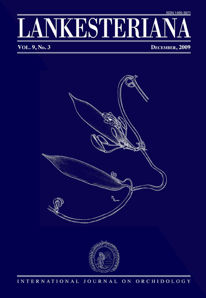<i>Sotoa</i>, a new genus of Spiranthinae (Orchidaceae) from Mexico and the southern United States
DOI:
https://doi.org/10.15517/lank.v9i3.52260Keywords:
Molecular phylogenetics, niche modeling, Orchidaceae, Sotoa, SpiranthinaeAbstract
Generic placement of “Deiregyne” confusa and “D.” durangesis has been inconsistent among several recent classifications of subtribe Spiranthinae based mainly on floral characters. In this work, we assessed the systematic position of these two species by means of cladistic parsimony analyses of nuclear (nrITS) and plastid (trnL-trnF) DNA sequences of 36 species/21 genera of Spiranthinae. Additionally, perceived differences in habitat preference between the two species were evaluated using geographic information system and niche modeling tools. Our results show that, in spite of their striking similarity in overall flower morphology, “D.” confusa and “D.” durangensis are only distantly related to one another. Instead, the former species is strongly supported as sister to Svenkoeltzia, whereas the latter groups with Schiedeella. Niche modeling revealed noticeable differences in the two species’ ecological preferences; no overlap of their potential distribution areas (as inferred using the Maxent modeling method) was predicted. A new monotypic genus, Sotoa, is proposed to accommodate “Deiregyne” confusa on the basis of genetic, morphological and (inferred) reproductive differences from other genera of the subtribe. The main morphological feature distinguishing Sotoa from other Spiranthinae is the folding of the bottom surface of the nectary, which is deeply concave from outside, resulting in an internally convex surface that is covered by dense pubescence.
Downloads
Downloads
Published
How to Cite
Issue
Section
License
According to the Open Access policy promoted by the University of Costa Rica, all the papers published by Lankesteriana are licensed under the Creative Commons copyright and can be downloaded free of charge. The journal holds copyright and publishing rights under the CC BY-NC-ND 3.0 CR license.
Before the publication of the materials submitted by the author(s) in LANKESTERIANA, the author(s) hereby assign all rights in the article to the Lankester Botanical Garden.





